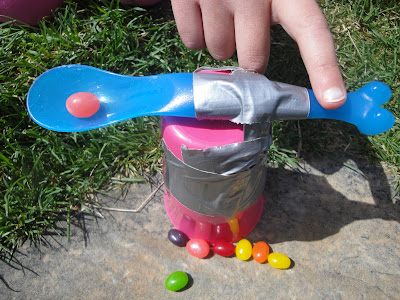SMMART MATH:
JELLY BEAN FLIPPER and PROBABILITIES.
Super Fun way to play with your food!
Build your own jelly bean flipper with a lever (spoon), duct tape and a fulcrum (Duplo lego, wooden block, cup or some other toy or object that you can hold still when your child is flipping). Twist a piece of duct tape into a cord. Slide a spoon inbetween the cord and the fulcrum. Tape both ends of the cord down on either side of the spoon (don't tape the spoon) to secure the spoon in place. The height of your fulcrum may determine the distance that the jellybean is hurled. You are creating a "first class" lever...if you want to learn more about 1st, 2nd and 3rd class levers, check out this link (http://www.professorbeaker.com/lever_fact.html).
Now place a jelly bean into the spoon's cradle and quickly apply force to the handle end of your lever/spoon. This will propell the jellybean into the air.
Use masking tape to put a line down on the carpet or place a stick in the grass to separate two areas outside. Now, with each flip, record the number of times (out of 10) that the jellybean landed on the side closest to you, or on the other side of the tape away from you.
You can help your child graph the number of times that the jelly bean landed on a certain side, or just determind the percentage of times that the jelly bean landed on one side or the other. If the jelly beans landed on your side 7 times (7 X 10 = 70%), even though there is a 50% probability that it will land on this side.
Flip those brightly colored jellybeans outside in the grass, and your child will have a super-fun time "hunting" where they landed.
Remember...Probability of an Event Equation:
The probability of event A is the number of ways event A can occur, divided by the total number of possible outcomes.
P(A)= The Number of Ways an event can occur
.........The Total Number of Possible Outcomes
P(launch) = 1 (#of ways can be launched) ..........
2(# of sides it can land on)







